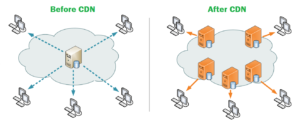Web page loading speed is something which most of the WordPress developers ignore, but it is one of the essential parts of the User experience. No user wants a webpage loading time to be greater than 500 milliseconds. At most 2 seconds is affordable. If the Web page loading time is greater than 2 seconds, it will inevitably affect the user base and SEO of the website. As today majority of the websites are built on WordPress platform, it becomes straightforward to control the speed of a webpage. In fact, WordPress developer can change the loading speed dynamically by using some tips and tricks.
Below mentioned are some of the remedies to remove the drawback of any webpage build on WordPress platform.
1. Use Lightweight Frameworks and Themes
An excellent visual appearance is crucial for any website to become popular. To make the visual presentations good WordPress developers add large images and high-end themes to create a website beautiful. Such themes and images are one of the reasons for drawback of the webpage. The best way to select the most appropriate theme is that we must carry out the performance tests on the sample web pages that contain that theme. If that theme passes the test, we can use it in the final design. Thesis framework and genesis framework based themes have a good reputation among WordPress development firms.
2. Power of Caching
Caching a webpage is something that most of the WordPress development firms do not perform. Caching a webpage means to save that page as a static page on the browser so that whenever the user will try to load that page again, it will access it from the browser memory and load it. This will exponentially increase the webpage loading speed. To cache a webpage the WordPress developer needs to install the plug-in for caching. We can also use expire headers for the implementation of browser caching. As the number of HTTP requests will decrease the speed of loading a webpage will increase. Apart from this fetching is also one of the processes that take time. So, prefetching the domains can also help improve the speed. Unnecessary plug-ins can also be one of the reasons for slow speed. Hence, we should neglect them.
3. Using CDN
CDN stands for Content Delivery Network. These are the networks which are made to deliver the user to the nearest server geographically so that the content can be provided quickly without much of traveling. Low transfer time will undoubtedly lead to less loading time. Such reduction in travel time can be made by reducing the number of hops that are performed across the network. One such plug-in that can be easily implemented is CDN enabler. The migration to CDN enabler is easy. All we have to do is just add two lines of code into the header.php file.
4. Compress Images
Every WordPress developer knows that the amount of size that an image occupies no other thing on the webpage occupies including themes. Using compressed images can not only reduce loading time but also improve the SEO of the website. Word Press development firms prefer to compress the image in the compression tool based on Operating system. Using such tools we can reduce the size of images by 50% with the minimum reduction in the quality. There are various tools such as SmushIt or Optimole available through which we can crop and resize any image.
5. Optimize SSL Handshake
SSL stands for Secure Socket Layer. SSL is also known as transport layer security because it works on the transport layer. As its name itself suggests that it is used to encrypt and secure client data on the web servers. It is one of the standards under HTTP transactions. It has one limitation that it increases latency because of the extra overhead. This problem can be solved by the using CDN which optimizes SSL handshaking. CDN reduces the time that it spends for the initial establishment. This helps in keeping the connections secure and alive. It also provides excellent support for the servers with lower rating and certification. In this case, only the end user’s browsers certificate matters.
6. Remove Old Revisions From Your Database
Keeping a clean database can help a WordPress based website from getting a slowdown. Keeping a limit on the number of post revisions can help us to continue cleaner database. Creating too many reviews is one of the limitations of using WordPress for website building. Such revisions occupy a lot of space on the servers which is one of the primary reason for the slow loading of a webpage. But it is great to hear that it has provisions to set a maximum limit for the creation of revisions. WordPress developers can enable or disable the limitation whenever they want.
7. GZip Compression
GZip plug-in can be used to compress JavaScript, web pages and CSS files at a server level. This can reduce the time taken in transferring the data from one place to another. One of the specialties of GZip is that it is effortless to use. By following a two-step process, we can cache or compress any file in just a few seconds. The first step is to visit the GZip official website and secondly select the appropriate plug-in for caching, select settings for browser cache and select HTTP GZip compression option. Performing these steps anyone can compress the file as mentioned above types.
Conclusion
Every WordPress Development firms believe in designing high performing websites. Also, there is no other way but the WordPress tool to create high-end websites. It won’t be justified if a user gets top performing websites by killing the loading speed of the website. This is the reason why the tips as mentioned above and tricks can be useful for every WordPress developer. Using these tricks, one thing is undoubtedly going to improve, and that is the performance of the website as a whole. Because at the end of the day we all want to see our consumers happy.





